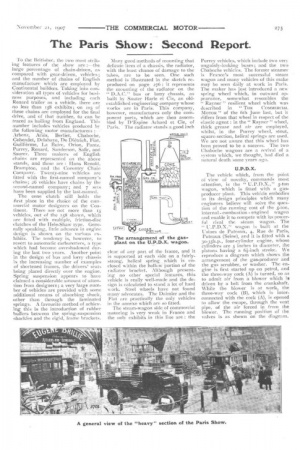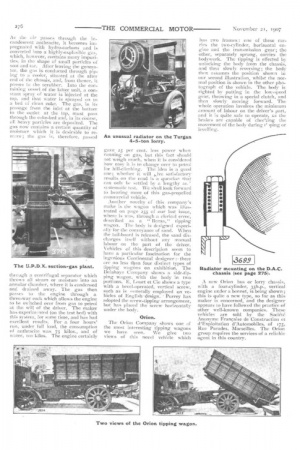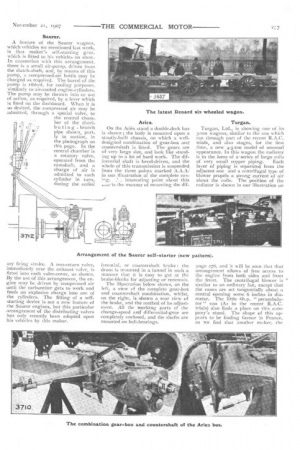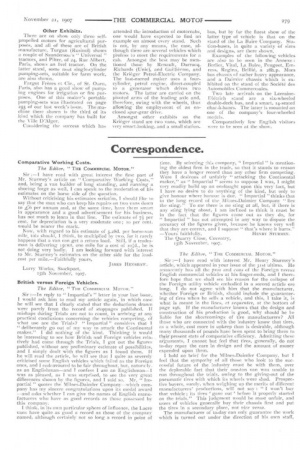The Paris Show : Second Report.
Page 13

Page 14

Page 15

Page 16

Page 17

If you've noticed an error in this article please click here to report it so we can fix it.
To the Britisher, the two most strikingfeatures of the show are :—the large percentage of chain-driven, as compared with gear-driven, vehicles; and the number of chains of English manufacture which are employed by Continental builders. Taking into consideration all types of vehicles for busiiteSS purposes, and including each Renard trailer as a vehicle, there are no less than 158 exhibits; on 103 of these chains are employed for the final drive, and of that number, 62 can be traced as hailing from England. This number includes vehicles produced by the following motor manufacturers : Arbenz, Aries, Berliet, Chaboche, Cohendet, Delahaye, De Dietrich, Fiat, Guillierme, La Buire, Orion, Pantz, Purrey, Renard, Sanderson, Safir, and Saurer. Three makers of English 4.thains are represented on the above stands, and these are : flans Renold, Brampton, and the Coventry Chain Company. Twenty-nine vehicles are fitted with the first-named company's chains; 26 vehicles have chains by the :second-named company ; and 7 sets have been supplied by the last-named.
The cone clutch still holds the first place in the choice of the commercial motor designers on the Continent. There are not more than 15 vehicles, out of the 158 shown, which are fitted with multiple, friction-disc clutches of the Hele-Shaw type. Generally speaking, little advance in engine design is shown on the various exhibits. The tendency is, however, to revert to automatic carburetters, a type which had become overshadowed (luring the last two years. Another point in the design of bus and lorry chassis is the increasing number of examples of shortened frames, the drivers' seats being placed directly over the engine. Spring suspension appears to have claimed a considerable amount of attention from designers ; a very large number of vehicles are provided with some additional means of absorbing shock, other than through the laminated springs. A favourite method of achieving this is the introduction of rubber buffers between the spring-suspensron shackles and the rigid, frame brackets. Many goad methods of mounting that delicate item of a chassis, the radiator, with the least chance of damage to the tubes, are to be seen. One such method is illustrated in the sketch reproduced on page 276: it represents the mounting of the radiator on the " D.A.C." bus or lorry chassis, as built by Sauter Harle et Cie, an oldestablished engineering company whose works are in Paris. This company, however, manufactures only the component parts, which are then assembled by D'Espine Achard et Cie, of Paris. The radiator stands a good inch
clear of any part of the frame, and it is supported at each side on a fairlystrong, helical spring . which is enclosed within the hollow portion of the radiator bracket. Although presenting no other special features, this vehicle is really well-made and the design is calculated to stand a lot of hard work. Steel wheels have not found many advocates. The Daimler and the Fiat are practically the only vehicles in the annexe which are so fitted.
The steam-wagon side of commercial motoring is very weak in France and the only exhibits in this line are : the
Purrey vehicles, which include two very ungainly-looking buses; and the two Chaboche vehicles. The former steamer. is France's most successful steam wagon and many vehicles of this make may be seen daily at work in Paris. The maker has just introduced a new spring wheel which, in outward appearance, somewhat resembles the " Rayner " resilient wheel which was described in " THE COMMERCIAL MOTOR" of the 6th June last, but it differs from that wheel in respect of the elastic agent in the " Rayner " wheel, thick grease and air are employed, whilst, in the Purrey wheel, stout, square-section, helical springs are .used. We are not aware that this wheel has been proved to be a success. The two Chaboche wagons are a revival of a ,,vstem which, we thought, had died a natural death some years ago.
The vehicle which, from the point of view of novelty, commands most attention, is the " U.P.D.X.," 5-ton wagon, which is fitted with a gasproducer plant. This vehicle embodies in its design principles which many engineers believe will solve the question of the running cost of the 5-ton, internal combustion engined wagon and enable it to compete with its powerful rival the steam wagon. The " Ll.P.D,X." wagon is built at the l_lsines de Puteaux, 4, Rue de Paris, Puteaux (Seine), and it is fitted with a 30-3511.p., four-cylinder engine, whose cylinders are 5 inches in diameter, the pistons having a 6.1-ineh stroke. We reproduce a diagram which shows the arrangement of the gas-producer and the gas scrubber, or washer. The engine is first started up on petrol, and the three-way cock (A) is turned, so as to admit air from a blower which is driven by a belt from the crankshaft. While the blower is at work, the three-way cock (B), which is interconnected with the cock (A), is opened to allow the escape, through the vent pipe, of the air forced in from the blower. The running position of the valves is as shown on the diagram.
As the air passes through the incandescent anthracite, it becomes impregnated with hydro-carbons and is converted into a highly-explosible gas, which, however, contains many impurities, in the shape of small particles of soot and tar. After leaving the generator, the gas is conducted through piping to it cooler, situated at the after end of the chassis, and, from thence, it passes to the :crubber. Into the Containing vessel of the latter unit, a constant spray of water is injected at the top, and I hat water is sprayed on to a bed of clean coke. The gas, in its passage from the inlet at the bottom to the outlet: at the top, must: pass through the coke-bed and, in its Course, all heavy particles are deposited. The gas now contains a certain quantity of moisture Which it is desirable to remove; the gas is, therefore, passed
through a centrifugal separator which throws all steam or moisture into an annular chamber, where it is condensed and drained away. The gas then passes to the engine through a three-way cock which allows the engine to he switched over from gas to petrol at the will of the driver. The maker has experimented (on the test bed) with this system, for some time, and has had excellent results. For a four hours' run, under full load, the consumption of anthracite was 75 kilos., and of water, too kilos. The engine certainly
gave 25 per cent. less power when running on gas, but this fact should itot weigh much, when it is considered how easy it is to change over to petrol for hill-climbing. The idea is a good one ; whether it will 5ive satisfactory results on the road is a question that can only be settled by a lengthy
systematic test. We ;hall look forward to hearing more of this gas-propelled commercial vehicle.
Another novelty of this company's make is the wagon which was illustrated on page 255 of our last issue, where is was, through a clerical error, described as a " Ilcrna," tipping wagon. The body is designed especially for the conveyance of sand. When the tail-board is released, the sand discharges itself without anv manual labour on the part of the driver. Vehicles of this description seem to have a particular fascination for the ingenious Continental designer there are no less than four distinct types of tipping wagons on exhibition. The Delahave Company shows a sick-tipping wagon, with the body in two ixwtions. E. Lotiet et Cie shows a type with a bevel-operated,vertical screw, such as is 0-enerally employed on vehicles of English-design. ' Purrey has adopted the screw-tipping arrangement, but has placed the screw horizontally under the body.
Orion.
The Orion Company shows one of the most interesting tipping wagons we have seen. We give two views of this novel vehicle which has two frames : one of these carries the two-cylinder, horizontal engine and the transmission gear; the other, separately sprung, carries the bodywork. The tipping is effected by unlocking the body from the chassis, and then slowly reversing; the body then assumes the position shown in our second illustration, whilst the normal position is shown in the other photograph of the vehicle. The body is righted by putting in the low-speed gear, throwing in a special clutch, and then slowly moving forward. The whole operation involves the minimum amount of labour on the driver's .part, and it is quite safe to operate, as the brakes are capable of checiiing the movement of the body during ti ping or A new Orion bus or lorry chassis, with a four-cylinder, 35h.p., vertical engine under a bonnet, is being shown; this is quite a new type, so far as this maker is concerned, and the designer appears to have followed the practice of other well-known companies. These vehicles are sold by the Sociiite Anonyme Francaise de Construction et d'Exploitation d'Autoinobiles, of 175, Rue Parades, Marseilles. The Orion group requires the services of a reliable agent in this country.
Saurer.
A feature of the Sauter wagons, which vehicles we mentioned last week, is that maker's self-startinggear, which is fitted to his vehicles on show. In connection with this arrangement, there is a small air-pump, driven from the clutch-shaft, and, by means of this pump, a compressed-air bottle may be charged as required. The barrel of the pump is ribbed, for cooling purposes, similarly to air-cooled engine-cylinders. The ptimp may be thrown into or out of action, as required, by a lever which is fixed on the dashboard. When it is so desired, the compressed air may be admitted, through a special valve, to the central chamber of the distributing-branch pipe shown, partly in section, in the photograph on this page. In the central chamber is a rotatory valve, operated from the camshaft, and a charge of air is admitted to each cylinder in turn, during the ordiriZ ary firing stroke. A non-return valve, immediately over the exhaust valve, is fitted into each valve-cover, as shown. By the use of this arrangement, the engine may be driven by compressed air until the carburetter gets to work and feeds an explosive charge into one of the cylinders. The fitting of a selfstarting device is not a new feature of the Sauter engines, but this particular arrangement of the distributing valves has only recently been adopted upon his vehicles by this maker. Aries.
On the Aries stand a double-deck bus is shown ; the body is mounted upon a stoutly-built chassis, on which a welldesigned combination of gear-box and countershaft is fitted_ The gears are of very large size, and look like standing up to a lot of hard work. The differential shaft is bevel-driven, and the whole of this transmission is suspended from the three points marked A.A.A. in our, illustration of the complete cas ing. interesting point about this unicls the manner of mounting the dif ferential, or countershaft brake ; the drum is mounted in a tunnel in such a manner that it is easy to get at the brake-blocks for adjusting or renewals.
The illustration below shows, on the left, a view .of the complete gear-box and countershaft combination, whilst, on the right, iS shown a rear view of the brake, and the method of its adjustment. All the working parts of the change-speed and differential-gear are completely enclosed, and the shafts are mounted.on.ball-bearings. Turgan.
Turgan, Ltd., is showing one of its 3-ton wagons, similar to the one which ran through part of the recent R.A.C. trials, and also stages, for the first time, a new 4-5-ton 'model of unusual appearance. In this wagon the radiator is in the form of a•series of large coils of very small copper piping. Each layer of piping is separated from the adjacent one and a centrifugal type of blower propels a strong current of air about the coils. The position of the radiator is shown in our illustration on page 276, and it will be seen that that arrangement allows of free access to the engine from both sides and from the front. The centrifugal blower is similar to an ordinary fan, except that the vanes are set tangentially about a central opening some 6 inches in diameter. The little 6h.p. "perambulator " van (Ai in the recent R.A.C. trials) also finds a place on this company's stand. The shape of this appears to be finding favour in France, as we find that another maker, the Socit:O3 de Construction de Vehicules Automobiles, has four similar vans mounted on " Royal " chassis, the general construction of which is somewhat similar to that of the Turgan.
Delahaye.
The Delahaye stand contains many fine examples in the heavy-vehicle line, and amongst these are two vehicles for lire-brigade work. One of these was illustrated on page 255 of our last issue : it is a splendid vehicle, with ample accommodation for the carrying of a large quantity of hose, standpipes and scaling-ladders, in addition to its crew of firemen. The other motor-propelled fire-appliance is theescape which we illustrate on this page.
There is also on this stand a twocylinder, io-32h.p, cab. It is designed to meet the Metropolitan regulations. There are about 250 similar vehicles of this make now in daily use in Paris, and this number will shortly be increased to 400. The side-tipping wagon illustrated opposite is another of this maket•s exhibits.
Darracq-Serpollet, The Darracq-Serpollet steam vehicles form a very prominent exhibit. The stand contains some very line examples of special bodywork, amongst which are : a van for the conveyance of two horsfs, together with their attendant grooms and harness; and a six-wheeled single-deck bus. We believe that this is the first six-wheeler built by this maker. All the springs are interconrwrted, in series, by the aid of bellcranks and rods. There arc also exhibited by this -company, several typical examples of its standard designs of site-en commercial vehicles, for both passenger and goods transport.
Stand d'Honneur.
On the Stand d'Honneur, directly opposite to the main entrance to the annexe, is staged one of the DarracqSerp:dlet vehicles which obtained the first prize in its class during the French trials last May, and here is also shown : the De Dion heavy wagon which recently won the special prize of the Minister of War; the Delahaye prize_ winner in Class 2 of the French trials; and the Aries single-deck bus which also did well during those trials._ The
idea of providing a stand, on which the " lions " of the year might be exhibited, has not received the support it merited. C.A.R.
The " Camion-Autobus Rotatif," or " C.A.R." chassis, is the only example of the rotary type of motor which is to be seen amongst the heavy vehicles. Much ingenuity has been expended by designers on this type of motor, with hut poor results. This particular vehicle is intended to carry a load of 4_ tons on its platform.
The engine is a four-cylinder one, and is air-cooled : the cylinders are inches in diameter, and the pistons have a stroke of 41inches; it is supposed to give 12-16h.p. at its normal speed of i,toor.p.m. The engine is arranged in a fairly accessible cupboard, under the driver's seat, and is enclosed in a sheet-metal tunnel through which air is drawn. The top half of the tunnel is hinged. The motor is illustrated on page 280, where it will be seen that the cylinders are provided with cast ribs to facilitate cooling. The idea is a clever one, but we doubt whether it will be found practical, on account of the intricate balancing, and crank-effort problems introduced. Other Exhibits.
There are on show only three selfpropelled motors for agricultural purposes, and all of these are of British manufacture. Turgan (Rusinol) shows a couple of Saundersoars " Universal " tractors and Piker, of 24, Rue Alib-ert, Paris, shows an Biel tractor. On the latter stand, some neat single-cylinder pumping-sets, suitable for farm work, are also shown.
Eargot Freres et Cie., of St. Ouen, Paris, also has a good show of pumping engines for irrigation or fire purposes. One of this maker's portable pumping-sets was illustrated on page 255 of our last week's issue. The machine there shown is the third of its _kind which the company has built for the Ville D'Alger.
Considering the success which bas
attended the introduction of motorcabs, one would have expected to find an example on almost every stand. Such is not, by any means, the case, although there are several vehicles which Profess to meet the requirements for a cab. Amongst the best may be mentioned those by Renault, Darracq, Richards (Uric), and Guillierme, and the Krieger Petrol-Electric Company. The last-named maker 1.15eS a fourcylinder, petrol engine, direct-coupled to a generator which drives two motors. The latter are carried on the pivoted arms of the leading axle and, therefore, swing with the wheels, thus allowing the employment of an enclosed spur-gear drive.
Amongst other exhibits Oil the Krieger stand are two vans, which are very smart-looking, and a small station_ bus, but by far the finest show of the latter type of vehicle is that on the stand of the La Buire Company. Station-buses, in quite a variety of sizes and designs, are there shown, Examples of the following vehicles are also to be seen in the Annexe : Berliet, Vital, La I3uire, Peugeot, Emress, Regina, Brillie., a 28h.p. Mors bus chassis ef rather heavy appearance, and a Daimler chassis which is exhibited on the stand of the Societe des u tomobi les Commerci ales.
Two late arrivals on the Lorraine Dietrich stand are a six-wheeled double-deck bus, and a smart, 14-seated char-A-bancs. The latter is mounted on one of the company's four-wheeled models.
Comparatively few English visitors were to be seen at the show.




















